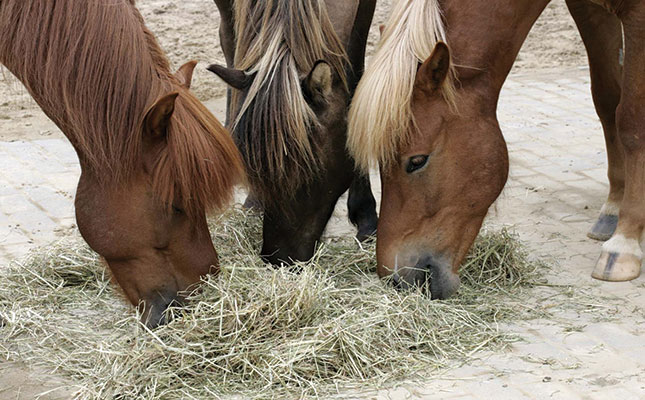
Photo: Wikimedia Commons
It has been known for centuries that feeding horses grain makes them fast and furious, the type of energetic behaviour required of racehorses and carriage horses.
A complete absence of grain, on the other hand, is also undesirable, as working horses will lack the energy to pull ploughs in winter, and sport horses will be unable to keep up when competing in racing, eventing or showjumping.
It is well known that donkeys and certain breeds of horses need high-fibre diets and will be prone to laminitis if fed even relatively small amounts of grain.
Starches and grains are digested mainly by enzymes in the horse’s stomach and small intestine, while the more fibrous feed, consisting of dry grass and hay, is digested slowly in the hind gut. Very soft green grass counts as a starch, rather than a fibre.
If there is an overload of starch in the stomach and small intestine, part of the undigested ingesta will pass unchanged through to the hindgut, where it will influence the composition of the microflora that digest fibre. This results in a high risk of developing health problems such as colic and stomach ulcers.
New studies
Research in more recent years has indicated that a horse’s nervous system and behaviour are also directly linked to the type and proportion of organisms that digest feed in its upper and lower gut. Researchers call this the microbiome-gut-brain axis.
This comprises four interacting systems: the autonomic nervous system, the enteric nervous system, the neuroendocrine system, and the immune system.
This finding helps explain the relationship between horse diets and the balance between the sympathetic (fight or flight) and parasympathetic (eat, digest and relax) state of mind.
In addition, as certain microbes multiply, they can produce chemicals that stimulate the nerves of the enteric and autonomic nervous systems and the hypothalamic-pituitary axis, resulting in a high level of flight-or-fight impulses and an increased heart rate.
Researchers in this field argue that the intestinal microbiome plays a key role in behaviour and cognition. Manipulating the diet alters the intestinal microbiome, which, in turn, should alter a horse’s behaviour in a reproducible and consistent manner. Scientists therefore advise that when managing the diet, a consistent approach is applied to stabilise both health and behaviour.
One of the practical ways that stable managers and owners can prevent an overload of starches causing indigestion in the hindgut is to split the concentrate into three feeds and make sure that the horse has ad lib access to hay or grazing, whether it is in the stable or paddock.
It seems intuitive that the balance of micro-organisms in a horse’s gut, and its behaviour, are influenced by adding specific probiotics to the feed. In fact, there are many probiotics on the market that suggest this option.
Unfortunately, the highly acid environment in the stomach and small intestine, caused by a high level of starches such as oats, maize or barley, inhibits the growth of organisms that digest fibrous foods in the hindgut. Therefore, adding probiotics to the diet will not prevent or modify the excitable behaviour of horses on a diet high in starches.
A better option for sport horses that require higher energy levels is to split the concentrate into three or more smaller feeds daily and make sure that hay or grazing is always available.
Dr Mac is an academic, a practising equine veterinarian and a stud owner.










